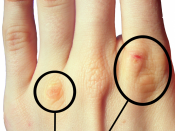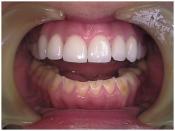I have written this report to inform readers of the causes and effects of a lesser known eating disorder, Bulimia Nervosa and to prove my theory that advertising leads to teenagers having poor body image and developing this disorder.
After detailed research I have found that media influences only a small percentage of what can lead to bulimia nervosa. Media along with biological, family, individual and many other factors comprise together to cause this disorder.
25% of individuals have admitted to knowing someone with bulimia (News poll, The Australian, 11/2/1998) but not all of these individuals knew the details of why that someone had bulimia or how they could help them or what will happen if they aren't helped. I am hoping that this report will help by informing you on this severe disease, should you or someone you know suffer from it.
1.0 What is Bulimia?
Bulimia Nervosa is an eating disorder that is of major social concern.
It is a cycle of bingeing and purging. Bingeing is classified as eating a large amount of food in a short time, and purging is ridding the body of all food to prevent weight gain. Purging is done by vomiting, diuretics, laxatives and other drugs. Excessive exercise is also used.
Perth's Eating Disorder Clinic's formal diagnosis of Bulimia is that "Bulimia Nervosa is when there are repeated episodes of binge eating with an obvious lack of control and then purging or vigorously exercising to prevent weight gain. This occurs on an average of two to five episodes for at least three weeks.
"83% of Bulimic patients purge by vomiting, 33% use laxatives and 10% take diet pills" according to the Royal Prince Henry Eating Disorders Unit in Sydney (1997)
2.0 Who is affected?
Bulimia sufferers are often girls. 1-3%...


